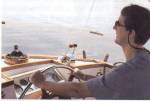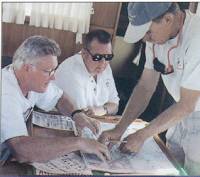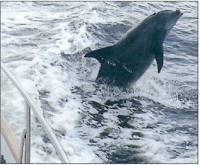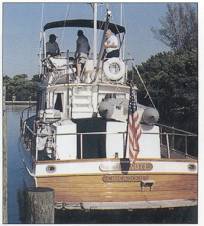|
Climb aboard as we cruise,
with a few bumps, through Southwest
Florida Yachts' seamanship school of
higher learning.
There
I sat on July 4th aboard a Grand Banks
36 Classic as fireworks blazed across
the night sky, casting a kaleidoscope
of colors on the glassy water. I slid
deeper into the cushioned deck chair,
sipped my frosty drink and marveled
at the view.
It
was my second night at Marinatown Marina,
just north of Ft.Myers, Fla., aboard
a "floating classroom" owned
and operated by Florida Sailing &
Cruising School (FSCS). I was there
as a participant in one of the school's
most popular courses, Basic Powerboating.
According to co-owners Barbara and Vic
Hansen, this three-day class was conceived
to teach nitty-gritty boating skills
in a relaxed environment, without stern
faces or raised voices. "We believe
that people learn and remember when
they're having fun," said Vic.
"This is a philosophy upon which
we've designed all of our courses."
As I student, I experienced that philosophy
firsthand.
Since
founding FSCS 16 years ago, the Hansens-
who also run the charter business Southwest
Florida Yachts- have stressed "the
personal responsibility and attitudes
necessary to be a successful boat operator,
charterer or owner." The school
offers 12 powerboat courses, ranging
from one-day safety seminars to 12-day
intensive cruises. Each class has received
the National Association of State Boarding
Law Administrators' seal of approval,
which means that upon completion students
may qualify for a marine insurance discount.
Upon
my arrival in balm Ft.Myers, I found
Blue Note, my home for the duration
of the course, at the dock and along
with my companion, Kristen Gilligan,
stepped aboard her weathered teak deck.
In the bright salon, our two classmates,
Scott Stone, a businessman from Dallas,
and Jim White, a trial court judge from
Brent, Ala., discussed their expectations
for the class.
Stone
co-owns a 27-foot Mako in Ft.Lauderdale
but his goal was to learn the skills
necessary for chartering larger boats
so that he could take more remote trips
with friends. White, on the other hand,
said he plans to retire in a few years
and buy a cruising boat with his wife,
Kay. He hoped to learn more about the
character of trawlers and how it felt
to live aboard one for a few days. (The
cost of the this course-$995 for three
days aboard a twin-engine vessel- included
overnight accommodations on board.)
White
began his research that evening. He
and Stone were assigned to the aft cabin
and its two single berths. Kristen and
I shared the forward cabin with a double
V-berth. Two heads, each with a shower,
enhanced our privacy. Before we headed
off to sleep, we stowed groceries to
the galley, located on the salon level
to port. (Students must provide food
for themselves and the instructor.)
The
course officially kicked off the next
morning. My classmates and I slid into
the L-shaped dinette and munched on
muffins as we awaited our instructor,
Capt. Gary Graham, who soon requested
permission to come aboard. Like all
of the school's instructors, our skipper
was a licensed U.S. Coast Guard captain.
He also had 11 years of experience with
FSCS; in fact, he wrote the course curriculum
and student guides.
Graham
walked us through the vessel, stem to
stern. "You get to wear many hats
as a charterer or boat owner: electrician,
plumber, mechanic," he said from
the engine room, normally concealed
beneath pull-up teak panels in the salon
floor. "It's not often that you
get to wear the captain's hat."
Next,
we tossed off the lines and headed out
to practice docking. Circling in the
protected waters of the marina, Graham
demonstrated how to "walk"
the twin-screw trawler by deftly shifting
the dual throttles back and forth "Every
few seconds, take a step back and look,"
he said. "If it's doing what you
want it to do, leave it alone, or you'll
just screw it up."

When
it was my turn at the wheel, I found
the twin 135-hp Ford Lehman diesels
responsive to short thrusts to throttle.
The lofty flybridge offered excellent
visibility. Afterwards, my classmates
each took the helm as Graham coolly
coached.
In
typical Florida summer fashion, a thunderstorm
prevented an afternoon dip from the
swim platform. Instead, Kristen and
I drove by car to nearby Sanibel Island,
the 45-minutes jaunt taking us along
the curvature of white beach. After
dining off Periwinkle Way, the island's
main strip, we toured back roads lined
with lush cypress and banyan trees.
Treasure hunting for conch and cockle
shells near the water's edge entertained
us for a time, and then we returned
to the mainland just a fiery golden
sunset dipped beneath the western horizon.
Day
two began with more docking, with increasingly
narrow slips and a few harsh brushes
against the pilings. Thank goodness
for rubrails. Graham spoke in one-word
sentences and then not at all, letting
us figure out for ourselves how to maneuver
the boat on its pivot point.
Tiring
of the bump and grind, we decided the
time was right to venture out of the
marina. We cruised at a leisurely six
knots into the Caloosahatchee River,
navigating the markers of the Intracoastal
Waterway and keeping a close eye on
our Furuno depthsounder. "Make
this piece of equipment your best friend,"
said Graham, warning us of Southwest
Florida's notoriously shallow water.
As
we wound our way upstream, Mediterranean-style
mansions gave way to mangrove-lined
shores. A bald eagle flew across our
bow, and two women fished from a beach
with seven-foot cake stalks. Again,
we each took the wheel in turn. Those
not at the helm relaxed under the bimini
top or snapped photos from the walkaround
deck. By the time we returned to Marinatown
that evening, Graham had taught us how
(and where) to anchor, how to negotiate
a lock and how to cruise safely using
the nautical "Rules of the Road."
The
night, Kristen and I enjoyed the Ft.Myers
fireworks and an Independence Day festival
at Tarpon Point Marina, across the river
from Marinatown. I finished my homework
and went to bed early, looking forward
to another day of the on-the-water activity.

We
began the final day of class with a
heavy-duty navigating session. Sitting
at the dinette with a compass, parallel
rulers, dividers and Southwest Florida
chartbook, we calculated variation,
deviation, dead reckoning, line of position
and every point in between. Afterward,
Graham surprised us with a written test
covering what we had learned in the
previous two and a half days.
After
the quiz, Stone took us out of the slip
as we prepared to bear west toward the
Gulf of Mexico. Along with more general
cruising along the ICW, the float plan
called for dropping dual anchors and
launching aboard.
"Dolphins,"
Graham yelled from the flybridge. I
grabbed my camera and rushed to the
bow in time to see two gray bodies leaping
alongside the boat. They were so close
I could nearly reach out and touch their
smooth skin as they emerged, then disappeared
into the depths.

The
Grand Banks cut smoothly through the
wind chop on its simidisplacemnt hull
for a few hours. Then, we prepared to
drop anchor. However, gray storm clouds
looming behind us demanded that we eat
and run. I'd have to try my hand at
dual-anchoring another day.
Back
at the slip, Kristen and I prepared
to disembark as the others discussed
ideas for their Basic Powerboating II
course, set to begin the next day. In
it, the instructor and students would
enjoy a three-day voyage away from Marinatown,
putting their knowledge to a real-life
sea test. I was sad to depart, especially
after overhearing their plan to anchor
off of nearby Useppa Island the next
night.
A
few weeks later, I called White to get
his reaction to the course. "All
in all, I thought the course was well
worth it," he said. In fact, he
and his wife are more serious than ever
about plans to buy a trawler. "Except
that I think we need something a little
bigger than a 36- maybe 42-footer."
The couple hopes to take another FSCS
course (an eight-day, round trip voyage
from Fort Myers to the Florida Keys)
in the next year. "The main thing
I learned was how much more I need to
study and practice," White said.
According
to the Hansens, there's always more
to learn about boating. "But there
is also immense satisfaction in learning
to do things the right way," said
Barbara. Like virtue, education is its
own reward.

|